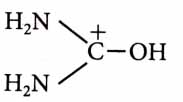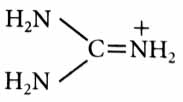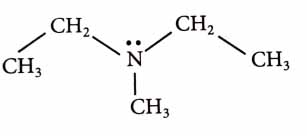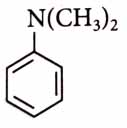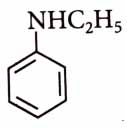Topic Question Set
Q 1
:
The correct order of decreasing basic strength of the given amines is [2025]
N-ethylethanamine > ethanamine > N-methylaniline > benzenamine
benzenamine > ethanamine > N-methylaniline > N-ethylethanamine
N-methylaniline > benzenamine > ethanamine > N-ethylethanamine
N-ethylethanamine > ethanamine > benzenamine > N-methylaniline
(1)
The correct order of decreasing basic strength of given amines is,

Electron releasing groups increase the basic strength of amines.
Q 2
:
Which one of the following compounds does not decolourize bromine water? [2025]
(3)
For decolourisation of bromine water, the molecule must be unsaturated hence cyclohexane cannot decolourise bromine water.
Phenol and aniline decolourise bromine water to give white ppt. of 2, 4, 6-tribromo derivatives.
Q 3
:
The major product D formed in the following reaction sequence is [2024]


(3)
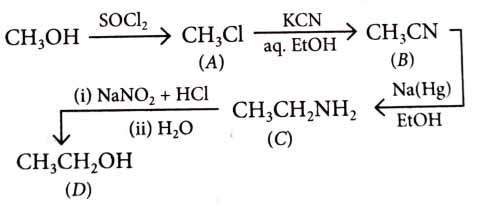
Q 4
:
The compound that does not undergo Friedel–Crafts alkylation reaction but gives a positive carbylamine test is [2024]
aniline
pyridine
N-methylaniline
triethylamine
(1)
Aniline does not undergo Friedel–Crafts reaction (alkylation and acetylation) due to salt formation with aluminium chloride, the Lewis acid, which is used as a catalyst. Due to this, nitrogen of aniline acquires positive charge and hence acts as a strong deactivating group for further reaction. Aniline, being a primary amine, gives positive carbylamine test.
Q 5
:
Given below are two statements:
Statement I : Aniline does not undergo Friedel–Crafts’ alkylation reaction.
Statement II : Aniline cannot be prepared through Gabriel synthesis.
In the light of the above statements, choose the correct answer from the options given below : [2024]
Both Statement I and Statement II are true.
Both Statement I and Statement II are false.
Statement I is correct but Statement II is false.
Statement I is incorrect but Statement II is true.
(1)
Aniline does not undergo Friedel–Crafts’ reaction due to salt formation with aluminium chloride which is used as a Lewis acid.
Aromatic amines cannot be prepared by Gabriel phthalimide synthesis because aryl halides do not undergo nucleophilic substitution with the anion formed by phthalimide.
Q 6
:
Which amongst the following compounds/species is least basic? [2023]
(2)
Q 7
:
Given below are two statements:
Statement–I : Primary aliphatic amines react with to give unstable diazonium salts.
Statement–II : Primary aromatic amines react with to form diazonium salts which are stable even above 300 K.
In the light of the above statements, choose the most appropriate answer from the options given below: [2022]
Both statement–I and statement–II are correct.
Both statement–I and statement–II are incorrect.
Statement–I is correct but statement–II is incorrect.
Statement–I is incorrect but statement–II is correct.
(3)
Primary aliphatic amines react with nitrous acid to form aliphatic diazonium salts which are unstable while aromatic amines react with nitrous acid at low temperature (273–278 K) to form diazonium salts, a very important class of compounds used for synthesis of a variety of aromatic compounds.
Q 8
:
Identify the compound that will react with Hinsberg’s reagent to give a solid which dissolves in alkali. [2021]
(4)
Benzene sulphonyl chloride , which is also known as Hinsberg’s reagent, reacts with primary amines to form sulphonamides. The hydrogen attached to nitrogen in sulphonamide is strongly acidic due to the presence of strong electron withdrawing sulphonyl group. Hence, it is soluble in alkali.
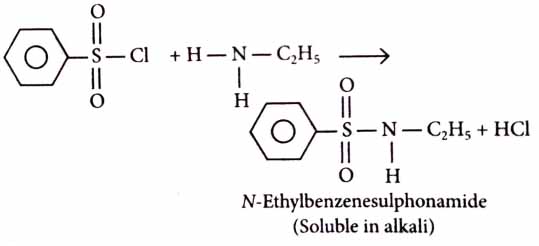
Q 9
:
Which of the following amines will give the carbylamine test? [2020]
(1)
Aliphatic and aromatic primary amines give carbylamine test. Secondary and tertiary amines do not show this reaction.
Q 10
:
The correct order of the basic strength of methyl substituted amines in aqueous solution is [2019]
(2)
The basicity of amines in aqueous solution depends on the stability of the ammonium cation or conjugate acid formed by accepting a proton from water which in turn depends on the -effect of alkyl group, extent of hydrogen bonding and steric factor. All these factors are favourable for amines. Therefore, amines are the strongest bases. If the alkyl group is small i.e., then there is no steric hindrance to H-bonding. Thus, the stability due to hydrogen bonding predominates over the stability due to -effect of — group and hence primary amine is a stronger base than amine. Hence, overall decreasing basic strength for methylamines in aqueous solution is







